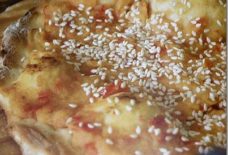Halawa: The Tahini Dessert
By: Lindsey Penn/Arab America Contributing Writer
Everyone knows that tahini or sesame paste is used throughout the Arab world, and especially in hummus. Did you know, though, that tahini can be used in Halawa? Also known as halva, Halawa is a popular and special dessert in the Arab world. In fact, the dessert is so popular that it has spread throughout the world and has been adapted in different cultures.
What is Halawa?
First off, there are two different kinds of Halawa or halva. One is made with flour as a base, and the other is made with nut butter as a base. Both are dense and sweet, but the difference in ingredients causes a different texture. The first known version of Halawa with sesame paste is from Suleiman the Magnificent, who ruled the Ottoman Empire from 1520-1566, although Halawa’s first written recipe is in Kitaab al-Tabikh (Book of Dishes) from the 13th century.
Flour-based
In this version, the Halawa uses semolina flour, cornstarch, or rice flour. It is made by frying the flour in the oil, turning it into a roux, and then adding sugar syrup. This method makes the Halawa more like a pudding but with a thicker texture.
If made with semolina flour, the recipe includes butter, ghee, or vegetable oil. The texture is gelatinous (think of polenta’s texture), but is still rich. Popular additions to the semolina Halawa are dried fruits such as raisins and dates and nuts such as almonds or walnuts, although there are other additional toppings. This variation is popular, especially in India and Pakistan.
As for cornstarch, the texture is also gelatinous. People in Greece tend to use cornstarch in this recipe.
Lastly, there is rice flour. Rice flour Halawa tends to have a version of dairy in it or coconut milk. Tanzania is known for rice flour Halawa with coconut milk.
Nut Butter as a Base
The nut butter base is what is more popular in the Arab world (and Turkey). Nut butter Halawa is made by grinding oily seeds (like sesame seeds or sunflower seeds) until it is a paste, then mixing it with hot sugar syrup. This cooks the Halawa until it is in a hard-crack stage.
Sesame Paste
Halawa with sesame paste or tahini is the version that is popular in the Middle East. It has sesame paste (tahini), sugar, and honey. Possible added flavors are pistachios, chocolate, or vanilla. This version is well known for the texture, which is crumbly. The sesame paste adds a few health benefits because it has a lot of protein, minerals, and vitamins and can boost the immune system.
Sunflower Paste
More popular in Eastern Europe, it has the same recipe as tahini Halawa, but with sunflower paste instead of sesame paste. It can also include nuts, cocoa powder, or vanilla.
Here are two recipes (one flour-based, and one nut butter-based):
Carrot Halwa (Flour-based)
This recipe is from Khushbu Shah on tastecooking.com.
Ingredients:
- 2 tablespoons ghee
- 2 pounds carrots (peeled and grated)
- 4 cups whole milk
- 1¼ cups granulated sugar
- ¼ cup powdered milk
- 2 teaspoons ground cardamom
- handful of mixed nuts, like almonds and cashews, for topping
Directions:
- Melt the ghee in a nonstick pot over medium heat and add the grated carrots. Stir for 4 to 5 minutes, or until the carrots are softened.
- Add the milk to the pot and continue to stir until the milk is completely evaporated.
- Add in the sugar. The sugar will release a lot of moisture, so keep stirring the mixture until the moisture evaporates. Apologize to your arm.
- Then add the milk powder to the pot. Stir to combine and cook for 4 to 5 minutes, or until the mixture thickens. Then stir in the cardamom powder.
- Garnish with nuts if you want. Serve hot or chilled.
Traditional Tahini Halva (Nut butter-based)
This recipe is from alfez.com
Ingredients:
- 2 cups honey
- 1 1/2 cups tahini, well stirred to combine
- Up to 2 cups toasted sliced almonds or other nuts (optional)
Directions:
- Heat honey on medium heat until your candy or instant-read thermometer reads 115°C or indicates the “softball” stage of candy making.
- To confirm that you are at the “softball” stage, drop a bit of the honey into a cup of cold water. It should form a sticky and softball that flattens when removed from the water.
- Have the Tahini ready to heat in a separate small pot, and once the honey is at the appropriate temperature, set the honey aside and heat tahini to 49˚C
- Add the warmed Tahini to the honey and mix with a wooden spoon to combine. At first, it will look separated but after a few minutes, the mixture will come together smoothly.
- Add the nuts, if using. Continue to mix until the mixture starts to stiffen, for a good 6-8 minutes. Pour mixture into a well-greased loaf pan, or into a greased cake pan with a removable bottom.
- Let cool to room temperature and wrap tightly with plastic wrap. Leave in the refrigerator for up to 36 hours. This will allow the sugar crystals to form, which will give the halvah its distinctive texture.
- Invert to remove from pan and cut into pieces with a sharp knife. Will keep for months in the refrigerator, tightly wrapped in plastic.
Check out Arab America’s blog here!









